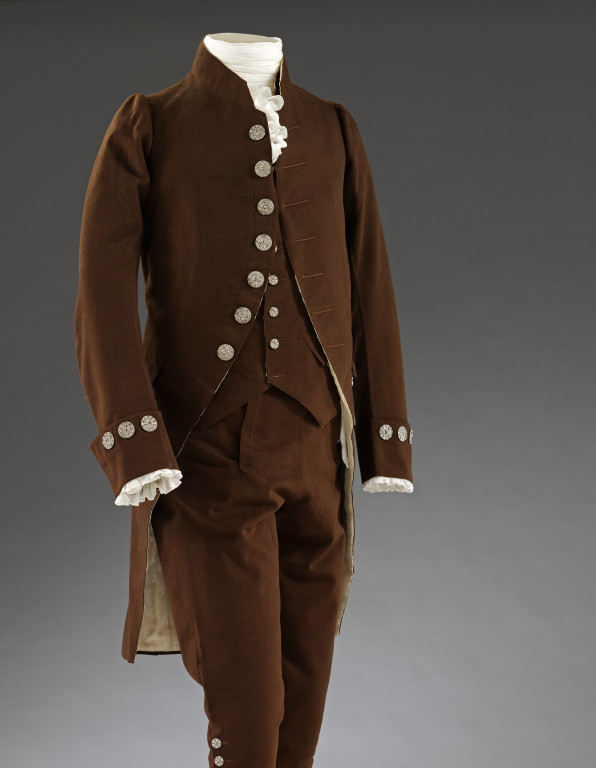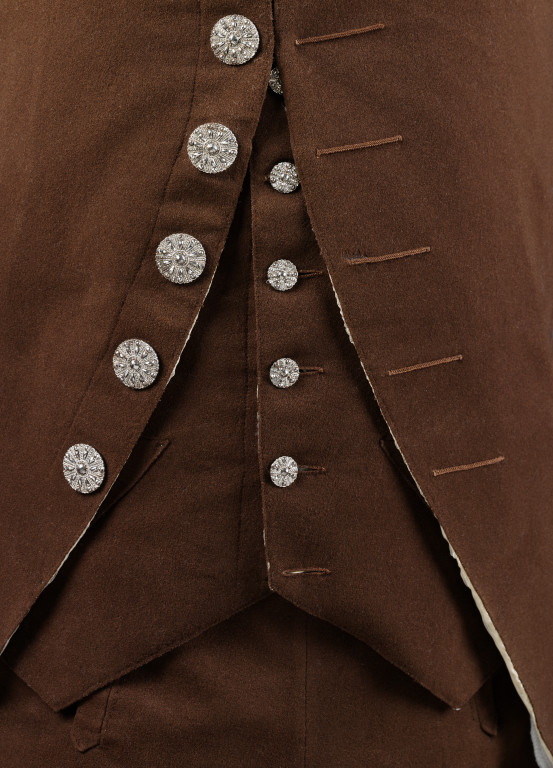The other week I found myself in the Textile Conservation studios, a microphone in front of me, contemplating how much sweat may have soaked into a coat. I should quickly make it clear that it wasn’t a coat being worn by a perspiring colleague, but rather a very smart wool coat dating from the 1780s.
The coat forms part of this rather fetching chocolate-brown, wool three-piece suit – one of a number of new acquisitions made for the Europe galleries since 2010. Although referred to as a coat, it is (as you can see below) what we today would instead call a jacket.

The reason for the microphone, was that we were recording a piece for one of the audio tours which will be available to visitors to the Europe Galleries. This particular audio tour will showcase ten objects, selected by curators as their ‘highlight’ of the Europe Galleries. Selecting just 10 objects from over 1,000 was quite a challenge!
In each case, a curator (or in one case a conservator) will speak in greater depth about a featured object, giving their own personal view of it. Audio tours are useful for allowing us to provide more detail than is possible in gallery labels. They are also a good opportunity for people to hear more subjective and personal takes on objects in a more informal style.
Where possible, recordings have taken place in front of the actual object, to help capture a sense of the object’s visual and physical impact when looked at extremely closely or when being handled. Descriptions of how an object feels against the skin will hopefully help to bring it ‘to life’ for visitors who won’t be able to touch it themselves. As the suit was still being worked on by conservators (and about to be mounted on a mannequin), I recorded my piece in the Textile Conservation studio.


The suit that I spoke about is made of plain high-quality dark chocolate-brown broadcloth, lined in silk and linen. It fastens with facetted cut steel buttons, and its black satin wig bag is still attached to the back of the coat.

The suit had to go through rigorous assessment and interventive treatment by textile conservators before being approved for display in the galleries.
The wool fabric used for the suit is an expensive closely woven fabric called broadcloth, a material that was shrunk, napped and shorn to produce a felted cloth which would have been waterproof and hardwearing. It is of a type manufactured in 18th-century France in Elbeuf and Louviers, near Rouen and Sedan in Flanders. It was also produced in England in the West Country. The close weaving and treatment of the fabric prevented any cut edges from fraying. On our suit, raw edges have been used wherever possible, including the collars and bottom edges of the coat and waistcoat and the waistband of the breeches. The broadcloth is attached to the lining in each case by a small running stitch, about 3mm from the edge. The broadcloth used for our suit is of very high quality material and was deemed to still be in excellent condition.

The overall structural state of the suit was very good but the lining was in a fragile and poor condition. The lining alone required about 250 hours of conservation to ensure that it was stable and would not be damaged further by handling, during and after mounting. For display, the suit will be fully supported on a custom-made torso in appropriate conservation-friendly materials.



The suit would have been made-to-measure by a skilled tailor and its close-fitting style provides a good impression of the shape and size of its owner. Like many historic garments, the suit appears rather small compared to today’s average body shapes. Current curatorial contemplation is that the suit was perhaps made for a young man who outgrew it before subjecting it to the wear that might have threatened its survival. – This is where my ruminations on sweat and wear-and-tear originated!


Thank you for the fashion, history, and rock n’ roll lesson. I was smitten with the V&A when I visited 34-years ago during my high school exchange.
Did you have the opportunity to take a pattern while conserving the suit?
This is an absolute treat to see in detail, and your description is marvelous. Thank you for sharing! I do love the deep netherworld of the V&A costume warehouse….
Hi Suzi,
We don’t take exact patterns of the clothing but we do take care to record numerous measurements and detailed notes about its construction. These help us with both the physical practicalities of mounting it on a suitable mannequin etc. and also for future research into various aspects of the garment.
Dawn